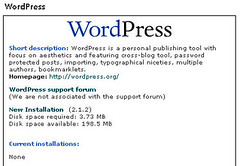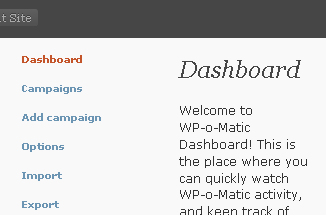(This is a re-post from my now-defunct website, BloggingFu)
Before we delve into the first technical setup of a blog aggregator using WordPress, it is imperative that you set a theme for your site: what type of content am I going to collect? Who is my target audience? How are my users going to use the content?
The blog aggregator I manage, Giuk.net, focuses on grabbing information from blogs whose owners are geographically related to one another, and the main purpose of Giuk.net is to bring together these content as a form of social networking between those blog owners and users of the aggregator, without having to subscribe to each and every RSS feed or having to put effort to discover new blogs of such. You should have a similar idea on how your content can be used and by whom.
Now, on with the show. Brace yourself, because this is going to be one long post (more so due to my ramblings).
I’m assuming you know what WordPress is and how to set up. If you don’t, you can do a Google search for “how to set up WordPress” tutorials. No offense, but don’t expect too much newbie tutorials here.
Note: This version of WordPress is the self-hosted version that you can freely download from WordPress.org, not the WordPress.com blog hosting service. No, you can’t create your blog aggregator at WordPress.com, no matter how much you beg for it.
I’m also assuming that you have a web hosting account that can support WordPress. The optimum server setup should basically be Linux + Apache + PHP + MySQL + PHPMyAdmin. From there, you can run the 3-step WordPress setup (or use Fantastico if you have one in your hosting account) before your blog aggregator installation starts. Yeah, do a Google search on this too if you’re not sure.
Once your WordPress is in place, you’re ready for this very important part.
STEP ONE: INSTALL WP-O-MATIC
I literally had someone I was helping online one sunny day, exclaimed “the hell??!!” to me via IM.
So, what the hell is WP-O-Matic?
Simply put, WP-O-Matic is a free WordPress plugin that pulls information out of a web site’s feed and adds it into your site as individual posts.
HELL YEAH!!
If nothing else, this would be the only plugin you need to add into WordPress for it to run as a blog aggregator (but there will be more, I promise).
If you’re running WordPress 2.8 or better, you can automatically install this plugin by going to the Plugins menu and clicking on Add New. The you do a search for the WP-O-Matic plugin and click the Install link. Once you have it installed and activated, you will need to go through a slightly lengthy (but clearly explained step-by-step) process of initially setting up the plugin.
This is where you should be concerned about what type of services your web hosting provider provides. Having a blog aggregator powered by WordPress would mean that you should have a function within your web hosting setting that can run a web server service called cron. Cron is a built-in service within a web server that can be used to automated the running of web scripts or commands within a specific time period you set, such as every 15th of the month, or every 30 minutes, or every Monday. What’s important here is for you to decide the frequency for your blog aggregator to automatically fetch the content of your registered users.
One important note: Although built into web servers (specifically ones running Apache), not all types of web hosting providers allows a cron service to run by their clients, or they block it altogether. They have their reasons, so go ask them why ![]() Basically, though, 99% of cheap or free web hosting providers will not have this option up.
Basically, though, 99% of cheap or free web hosting providers will not have this option up.
Coming up in part three of my blog aggregator how-to article: installing another important plugin to your WordPress blog aggregator, and step-by-step guide on adding content.
Stay tuned.
Check out my other posts: « Blog Aggregator: how to create one with WordPress, part 1 / Blog Aggregator: how to create one with WordPress, part 3 »


